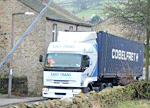An end to lorries through villages?
A new Government measure could give local councils the power to redirect lorries around villages if they’re using their satnav


At last, a Government measure has been announced that should be popular with everyone in the countryside. Plans unveiled last week would give local councils the power to deem certain roads unsuitable for large vehicles by reclassifying them, thus preventing satnavs from suggesting them.
Currently, only the Department of Transport can reclassify roads, and councils have been deterred from intervening by the amount of bureaucracy involved. When road statuses have been changed, information will be passed to satnav manufacturers, who can re-direct drivers accordingly.
The move comes after several accidents involving coaches and lorries being wedged under bridges or stuck down single-track lanes due to following their satnavs. There has also been a steady rise in complaints from villagers saying commercial vehicles are destroying ancient roadside buildings and endangering pedestrians.
In Hampshire, Sir George Young MP had promised villagers in Kingsclere that he would bring up the satnav issue in Parliament. Anthony Greayer, who has been leading the village's campaign for a Traffic Regulation Order (TRO) that would limit lorries using it as a rat-run, says: ‘We would welcome the new law, provided it could be imposed without it being a costly process. Unfortunately, we've been told by Hampshire County Council that a TRO is expensive.'
Mr Greayer adds: ‘A survey showed that the criteria [for a TRO] were overwhelmingly met, but the council would still prefer a lower-cost alternative. This is despite the fact that, on Swan Street alone, we have 40 listed buildings where windows rattle, pictures fall off walls and people are afraid to open their front doors for fear of being hit. Signs will have little impact on those HGV drivers who know the route already.'
Europe's largest provider of satnav systems, TomTom, welcomes the news, as does the CPRE. In Freshford, Somerset, a seven-year campaign ended last year, when residents were allowed to erect signs saying the tiny lanes were ‘unsuitable for heavy goods vehicles', and Satnav data-provider Navteq agreed to delete the route.
Exquisite houses, the beauty of Nature, and how to get the most from your life, straight to your inbox.
Country Life is unlike any other magazine: the only glossy weekly on the newsstand and the only magazine that has been guest-edited by His Majesty The King not once, but twice. It is a celebration of modern rural life and all its diverse joys and pleasures — that was first published in Queen Victoria's Diamond Jubilee year. Our eclectic mixture of witty and informative content — from the most up-to-date property news and commentary and a coveted glimpse inside some of the UK's best houses and gardens, to gardening, the arts and interior design, written by experts in their field — still cannot be found in print or online, anywhere else.
-
 Who won the rivalry between Turner and Constable? It was us, the public
Who won the rivalry between Turner and Constable? It was us, the publicA forthcoming exhibition at Tate Britain that revives the rivalry between these two 19th century painters sheds new light on their relationship.
-
 A 500-year-old house with interiors by Soho House's designer, gardens by an RHS Chelsea gold medallist and its own grass tennis court
A 500-year-old house with interiors by Soho House's designer, gardens by an RHS Chelsea gold medallist and its own grass tennis courtHaslingfield Manor is an extraordinary mix of styles and ideas, from Tudor Britain to the cutting edge of modern design. Penny Churchill takes a look.
